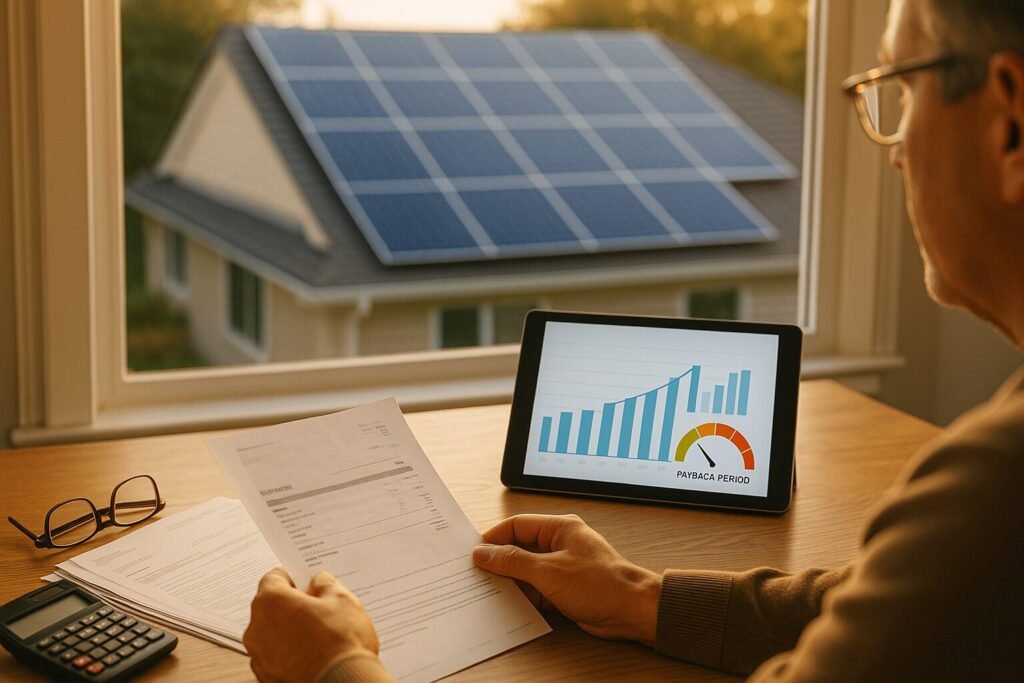Are Solar Panels Worth It? Payback & ROI Guide
See if solar pays off. Estimate payback from solar panel cost, rates, incentives, and net metering—plus when batteries help your ROI..
1) TL;DR Snapshot (for skimmers)
If your roof gets decent sun and you pay average-to-high electric rates, solar often pays for itself in 6–12 years, then keeps saving for decades. The biggest ROI swings are your utility rate, self-consumption vs export, installed cost, and incentives. Add batteries when you value backup or TOU bill control—not just for raw ROI. Get 2–3 quotes, run the simple payback math below, and sanity-check your numbers with your utility plan.
Quick hits
- Worth it when: solid sun, fair pricing, usable incentives, good TOU match.
- Slow payback when: heavy shade, very low usage, low export/buyback, costly re-roof needed now.
- First step: pull 12 months of kWh and your current rate plan.
2) How to Calculate Your Payback (Step-by-Step)
I like simple math first, fancy modeling later. Here’s the exact walkthrough I used for my own home.
You’ll need
- Last 12 months of usage (kWh) from your bill
- Your current rate (¢/kWh) and rate plan (flat or TOU)
- A system quote: size (kW DC) and total price
- A quick production estimate (see PVWatts below)
Production estimate (fast & free):
Use NREL PVWatts to estimate kWh/year for your roof. Note azimuth (direction), tilt, shading, and a performance ratio (derate) roughly 0.80–0.90.
Payback formula (cash purchase):
Payback (years) = Net Upfront Cost ÷ Year-1 Bill Savings
ROI (lifetime, simple view):
ROI = (Lifetime Savings − Lifetime Costs) ÷ Net Upfront Cost
Worked example (swap your numbers):
- System size: 7.0 kW
- Gross price: $21,000 (example)
- Federal tax credit (as of 2025, typically 30%): −$6,300
- Net cost: $14,700
- PVWatts production: 9,450 kWh/year
- Your rate: $0.28/kWh
- Year-1 savings: 9,450 × 0.28 = $2,646
- Simple payback: $14,700 ÷ $2,646 ≈ 5.6 years
Reality check: TOU plans, export rates, and future rate changes will nudge this number. We’ll adjust for those next.
3) The Big ROI Levers (What Moves the Needle Most)
- Electric rate & tariff: Higher ¢/kWh → faster payback. TOU can be a win if you use or export during peak times.
- Usage & load timing: More self-consumption at peak value = bigger savings.
- Sun hours/irradiance: Location + tilt/orientation + shade set your kWh/year.
- Installed cost ($/W): Every $0.10/W shift can change payback by months.
- System size: Right-sizing matters—oversizing into low export rates slows ROI.
Back-of-napkin sensitivities (same 7 kW, 9,450 kWh/yr):
| Rate (¢/kWh) | Year-1 Savings | Payback on $14.7k Net |
|---|---|---|
| $0.20 | $1,890 | 7.8 yrs |
| $0.28 | $2,646 | 5.6 yrs |
| $0.36 | $3,402 | 4.3 yrs |
4) Incentives: Tax Credits, Rebates, and How They Change Payback
- Federal credit (residential clean energy credit): Often 30% of eligible costs (equipment + labor). Consult your tax pro.
- State/utility rebates: These can stack and shorten payback further.
- Where to check: DSIRE (U.S. incentive database)
Cost waterfall (example):
Gross $21,000 → State rebate −$1,000 → Federal credit −$6,000 = Net $14,000
Tip: Incentives can impact what’s considered “basis.” Read the fine print and keep every receipt.
5) Net Metering & Export/Buyback: Still Worth It?
Not all exported solar kWh are paid equally.
- Full retail NEM: Exported kWh credited at your retail rate—great for payback.
- Reduced export/buyback: Exports earn less than retail. Focus on self-use (run laundry/dishwasher mid-day, pre-cool home, charge EV).
- TOU plans: Try to match your production with peak windows or store energy to discharge at peak.
Mini scenarios (very simplified):
- Full NEM: You save close to retail for most kWh → fast payback.
- Export < retail: Each exported kWh earns less → moderate payback.
- Export caps: Size carefully and shift loads → still good if self-consumption stays high.
6) Cash vs Loan vs Lease/PPA: How Financing Reshapes ROI
Cash:
- Fastest payback, highest NPV, no interest costs.
- Best if you have the capital and plan to stay put.
Loan:
- Compare the monthly payment vs the monthly bill savings.
- Aim for positive cash flow in Year-1 or near break-even with strong long-term savings.
- Watch interest rate, fees, and prepayment options.
Lease/PPA:
- Low upfront. You “buy power,” not the system.
- Often slower long-term value; can complicate home resale.
- OK if cash is tight and you prioritize simplicity.
7) Batteries: When They Help (and When They Don’t)
I added storage mainly for peace of mind during outages—and to squeeze value from a TOU plan.
Economics to consider
- TOU arbitrage: Charge from solar mid-day, discharge at peak.
- Demand charges (rare for homes): Batteries can clip peaks.
- Backup value: Hard to price, but real if you face frequent outages.
- Incentives for storage: Some regions offer separate rebates—check DSIRE.
Sizing tip: Start with critical loads (fridge, lights, internet, a few outlets). Expand if economics or resilience needs justify it.
Example: If a battery lets you shift 6 kWh/day into a $0.25/kWh premium window, that’s ~$1.50/day or ~$45/month before losses—enough to change ROI for some homes, not for others.
8) Lifespans, Replacements, and O&M (Realistic Lifecycle)
- Panels: Warranties often 25 years with ~0.3–0.7% annual degradation.
- Inverters: String inverters commonly last 10–15 years; microinverters/optimizers may last longer—budget for a future replacement.
- Batteries: Cycle-life driven; plan for replacement within the 10–15 year window depending on usage.
- O&M: Occasional cleaning, monitoring alerts, maybe a service call.
Pro move: Build a 25-year schedule that includes an inverter swap and potential battery refresh so your ROI isn’t rosy by accident.
9) Electricity Price Growth (Inflation): What Should You Assume?
I run three cases for sanity: 0%, +2%, +4% per year. Don’t bank on aggressive escalation to “force” a payback.
| Escalation | 25-yr Savings Impact |
|---|---|
| 0% | Conservative baseline |
| +2% | Moderate boost |
| +4% | Optimistic—use with caution |
10) Site & Design: Roof, Tilt, Orientation, Shade, Location
- Azimuth: South is best (N. Hemisphere), but SW/SE can be close.
- Tilt: Match local latitude or your roof pitch; not perfect? It’s okay—production is resilient.
- Shade: Trees, chimneys, neighbors—consider microinverters/optimizers to reduce mismatch losses.
- Alternatives: Ground mounts or carports can beat a bad roof.
- Regional irradiance: Your cousin in the desert will outproduce your coastal cottage.
Deep dive: Solar Panel Efficiency • Solar Panel Placement Guide • Do Solar Panels Work on Cloudy Days?
11) Home Value: Does It Move the ROI Needle?
Owned systems (not leased) generally help at resale when you can show:
- Production history (download from your monitoring app)
- Warranties & permits neatly filed
- Utility bills before/after
Leased or PPA systems may require transfer paperwork. Neutral to positive, but disclose early.
12) Special Situations: Is Solar Worth It If…?
- Low usage/vacation home: Consider a smaller array, aim for self-consumption, or explore community solar.
- TOU plans: Great with daytime loads or a battery for peak shaving.
- Condos/HOAs: Check roof rights; sometimes balcony PV or carport is allowed, or join community solar.
- Off-grid: Different math altogether—include generator fuel, battery replacements, and higher maintenance.
Related reads:
Grid-Tied vs. Off-Grid Solar Systems • Solar System Components Explained • How Long Do Solar Panels Last?
13) Three Quick Personas (Mini-Models)
A) High bill, good roof, cash buyer
- Expect short payback (often under 7 years).
- Verdict: Go. Add battery only if TOU or outages justify it.
B) Average bill, loan, reduced export rate
- Neutral to slightly positive monthly cash flow.
- Verdict: Still good—shift loads to mid-day; consider a small battery later.
C) Low usage, shaded roof, curious about PPA
- Savings are limited; export is low-value; shade hurts production.
- Verdict: Pause. Fix shade, price a smaller array, or consider community solar.

14) DIY Your Numbers: Copy/Paste Worksheet
Fill this mini-table with your data:
| Input | Your Number |
|---|---|
| System Size (kW DC) | |
| Gross Cost ($) | |
| Incentives ($) | |
| Net Cost ($) | |
| Est. Annual Production (kWh/yr) | |
| Rate (¢/kWh) | |
| Year-1 Savings ($) = kWh × rate | |
| Simple Payback (yrs) = Net ÷ Year-1 Savings |
Tools I use:
- Production: NREL PVWatts
- Incentives: DSIRE
15) Common Mistakes That Skew Payback
- Overestimating production or future rate escalation
- Forgetting inverter/battery replacements
- Misreading TOU/export rules
- Ignoring roof work or main panel upgrades
- Oversizing into low export rates with little self-use
16) FAQ (quick answers, link to sections)
- How accurate are online calculators? Good for ballparks—confirm with PVWatts and your exact rate plan.
- What if I’ll move in 5–7 years? Factor in the home value bump and transferability.
- Should I oversize for a future EV? Maybe. Add conduit now; expand later if export rates are weak.
- Do I need permits and inspections? Yes—your installer or AHJ handles this; keep copies for resale.
17) Conclusion: A Simple Decision Flow
- Good sun + fair pricing + usable incentives? → Keep going.
- Rate plan fit (TOU/export) + self-consumption plan? → Strong case.
- Cash or affordable loan with realistic assumptions? → Numbers likely work.
- Battery: Add for TOU/backup; skip if pure ROI is your only goal.
Next steps today
- Pull your 12-month kWh and rate
- Run PVWatts for kWh/year
- Get 2–3 quotes and fill the worksheet
- Post your numbers in the comments—I’m happy to sanity-check.
🔶 Skim-Stopper Box: 3 Fastest Ways to Improve Payback
- Shift loads to mid-day: laundry, dishwasher, EV charging.
- Right-size the array: avoid low-value exports.
- Stack incentives: claim federal credit and check local rebates.
✔️ Buyer Confidence Checklist
- I’ve modeled Year-1 savings using my actual rate plan
- I included inverter/battery replacements in the math
- I confirmed incentives on DSIRE and kept all receipts
- I have two quotes with apples-to-apples $/W and warranties
- I understand my export or TOU rules
Helpful Internal Links
- Solar Panel Efficiency: Real-World Factors & Fixes
- Solar Panel Placement Guide
- Do Solar Panels Work on Cloudy Days or at Night?
- How Long Do Solar Panels Last? (Lifespan & Warranties)
- Grid-Tied vs. Off-Grid Solar Systems
- Solar System Components Explained
- The Basics of Solar Energy: From Sunlight to Electricity
Helpful External Links
- Production calculator: NREL PVWatts
- Incentives database: DSIRE
- U.S. electricity prices: EIA
Final thought
I’ve made all the optimistic mistakes—overestimated the sun, ignored TOU quirks, forgot an inverter swap. The fix was simple: build a plain-English worksheet, pressure-test assumptions, and only then chase shiny extras like storage.
